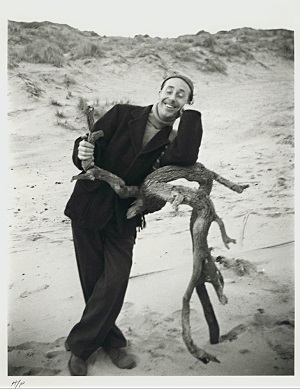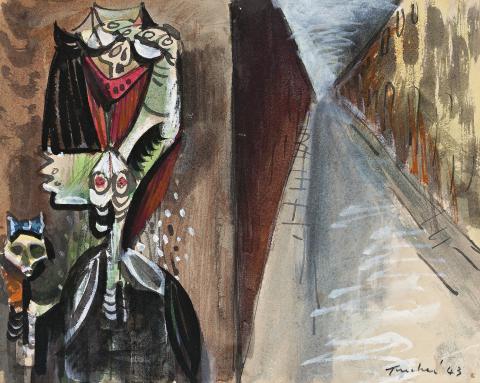IMAGE OF MODERN EVIL, 1943
ALBERT TUCKER
watercolour and ink on paper
20.0 x 25.0 cm
signed and dated lower right: Tucker ‘43
Tolarno Galleries, Melbourne (label attached verso)
Private collection, Melbourne
Deutscher ~ Menzies, Sydney, 10 March 2004, lot 108
Gould collection, Melbourne
Image of Modern Evil I, 1943, oil on canvas on composition board, 30.4 x 35.7 cm, collection National Gallery of Australia, Canberra
19. Tucker Driftwood.jpeg

The modest size of this watercolour belies its importance in Australian art for it is none other than Albert Tucker’s original study for Image of Modern Evil I (collection of National Gallery of Australia, Canberra), a startling painting from March 1943 which heralded this country’s most significant artistic response to the effects of wartime on the local psyche. Tucker, by his own admission, had a highly conservative view of sex and hedonism and had only recently returned to Melbourne following an army posting in regional Wangaratta. In the interim, his childhood city had irrevocably changed, becoming ‘a Babylon, a morass of unbridled drunkenness, violence and sexual excess.’1 Rather than express his moral distress with literal and realistic depictions of the population, he developed instead a cast of stylised figures, terrifying in their gaunt intensity, genitals flashing, eyeball heads wobbling on stalks and, above all, a leering grin in a savage crescent mouth.
The Image of Modern Evil, 1943 offered here was painted in Jolimont where Tucker shared a tiny room with his wife, the artist Joy Hester. In it, two nightmare figures are seen lurking at the end of a darkened city passage. With her breasts exposed, the female figure holds the hand of an emaciated child, an awful little figure that had its own genesis in a period Tucker spent at the Heidelberg Repatriation Hospital drawing the wounded patients, mostly returned soldiers bearing horrifying facial wounds. Tucker remembered one patient in particular, a young soldier whose nose had been sliced off by shrapnel revealing his nasal cavities. His drawing of this victim is graphic in its detail and informed a small group of subsequent paintings with the collective title of Victim. Each shows this ruined face transferred to the body of starving child and this apparition now appears in this first Image of Modern Evil.
There were multiple reasons for the unexpected outbreak of licentious behavior in Melbourne, but triggers included the vicious murders of three young women in the dimly lit city by an American GI in May 1942, and the subsequent influx the following month of 30,000 American soldiers. Melbourne simply exploded. Women now undertook wartime employment, and this new independence was ‘equated with sexual license and moral degradation. Women did have more sexual power: they were in demand and they could pick and choose from admiring swains.’2 The papers were filled with multiple reports of young couples drunkenly groping in full public view, vomiting in the streets or shouting aggressively at passers by. It was little wonder that the ‘suburban, puritan, Edwardian’3 Tucker felt compelled to articulate his distress. With her arm lifted to her head as she searches for a brief companion, this ‘modern, evil’ woman’s mouth is a lascivious slash of wanton desire. Tucker also incorporates the city location as its own character in the scene, one where light is not offered a source of beneficial illumination but instead acts as ‘a moment of unpleasant revelation where frightening personages and shameful acts are exposed.’4 Stark, powerful and historically significant, this Image of Modern Evil retains its magnetic force some 75 years after it was first created.
1. Yule, J., ‘The Paintings of Albert Tucker’, Albert Tucker: the mythologies & images, Lauraine Diggins Fine Art, Melbourne, 1990, p. 4
2. Burke, J., Australian Gothic: a life of Albert Tucker, Knopf Random House, Sydney, 2002, p.207
3. Tucker, A., quoted in: Mollison, J. and Minchin, J., Albert Tucker: a retrospective, National Gallery of Victoria, Melbourne, 1990, p. 10
4. Burke, J., op. cit., p. 251
ANDREW GAYNOR
